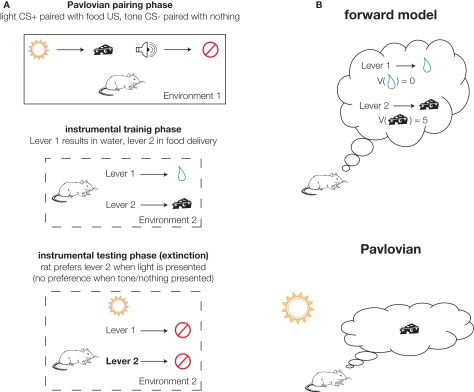Figure 3.
Expectancies generated by specific Pavlovian-instrumental transfer (PIT) and an internal forward model. (A) Schematic representation of a canonical specific PIT experiment (after Kruse et al. 1983). The animal is exposed to Pavlovian pairing of a light (conditioned stimulus or CS+) preceding food delivery (the unconditioned stimulus or US). Then, in a different environment, the animal learns to press lever 1 to obtain water and lever 2 to obtain food (the same food as in the pairing phase). Ideally these are calibrated such that the animal presses both equally.A specific PIT effect is obtained if, during the critical testing phase, the effect of presenting the light CS+ is to bias the animal's choice towards lever 2 (which previously resulted in food, as predicted by the light). Because this effect is specific to the food, it requires the animal to have an expectancy of the food when pressing lever 2. (B) Illustration of the distinction between outcome expectancies generated by an internal forward model (top) and presentation of the light CS+ (bottom). In the forward model case, the animal predicts the outcomes of the different available actions [which are then thought to be available for dynamic evaluation (V)]. In the Pavlovian case, the food outcome is activated by the learned association with the light cue, in the absence of a forward model.

